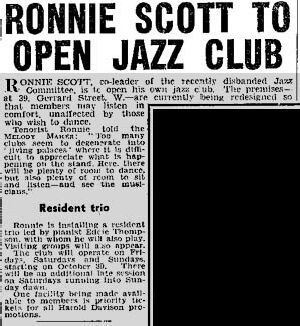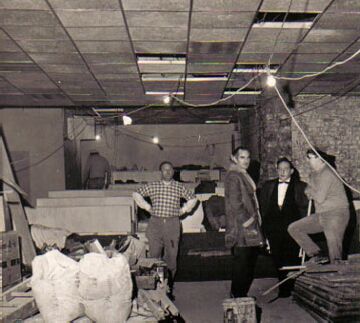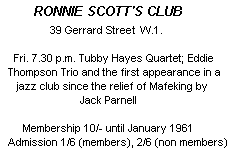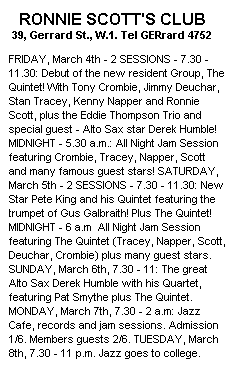










          |
| ronnie scott's 39 Gerrard Street... |
 |
Ronnie Scott and Pete King opened their first club at 39 Gerrard Street, in London's Soho district in 1959. Six years later they moved to larger premises in Frith Street, also in Soho, and just a few doors away from the original place. Pete King, like Ronnie, a tenor saxophonist gave up playing to devote all his energies to running the Club. It has become what is widely regarded as the premier jazz club in the world today and has operated at Frith Street for the past forty years...
|
Pete King's long partnership with Ronnie Scott is a remarkable tribute to their compatability. You could be forgiven for thinking that Scott, a rather diffident and introspective man offstage was the nail biter of the two with King the rock-steady, feet on the ground man. Not true says Pete: |
Ronnie's never been a worrier, his attitude has always been "What can we lose?" - I'm the one who worries. When Pete and Ronnie founded the club in 1959 they had absolutely no ambition to develop the place into the internationally known nightspot that it became. The premises were a small basement in Soho's Chinatown and had been a cabbie's cafe by day and a casino at night where Chinese gamblers played fan-tan for cash. The premises had no proper toilet facilities, fire exit or alcohol licence and cosmetic works continued after the club was opened. Pete continues: I think Ronnie borrowed two or three thousand pounds from his stepfather and we got ourselves in hock on hire purchase. I suppose it was quite a venture for working musicians who were collecting about a fiver a gig in those days - but it was only intended as a place where British musicians could jam... At the beginning the club was unlicensed and this, coupled with the fact that there was no room to dance - yes they actually danced to jazz in those days - meant that attendance was very disappointing. Licensing laws were much tougher then and in order to serve alcohol we had to be a bona fida club with rules and membership cards and all that carry on. We new very little about the booze situation but we did manage to get an 11pm licence. That still didn't do the trick so our next move was to go out after the name musicians which was not easy in those days. I went to the States and negotiated with the American Federation of Musicians - and that was our first real breakthrough. It was in November 1961 that Zoot Sims opened a four week season at 39, Gerrard Street and he was the harbinger of a whole string of American guests whose chosen instrument by some astonishing co-incidence happened to be the tenor saxophone - Lucky Thompson, Dexter Gordon, Al Cohn, Johnny Griffin, Roland Kirk, Stan Getz, Sonny Stitt, Ben Webster, Sonny Rollins and Benny Golson. Despite the star names policy the club was in a disastrous position financially as Pete King continues: We were never in profit at any stage of the seven years we were at Gerrard Street because the capacity was insufficient to generate enough revenue. We knew that if we were ever going to make it work we would have to get bigger premises, although by this stage our overdraft was substantial.
|  The original article in the Melody Maker in 1959 announcing the new club. It contains a glaring error in the first sentence in that Ronnie had been co-leader of the Jazz Couriers not the Jazz Committee. Opening night...  The move to 47 Frith Street in 1965 | |
|
Ronnie Scott: On Friday 31st October, 1959 came the moment which I had been anticipating, off and on, since that night on 52nd Street in 1947 when I'd seen the Charlie Ventura Bop For The People Band in full cry and marvelled at the electric atmosphere of the club. We launched Ronnie Scott's Club with a stentorian fanfare of publicity and a positive fusillade of advertising - a four inch single column spot in the classified section of Melody Maker (right). That was the first of a series of none-too-serious weekly advertisements which we hoped would grab a bit more attention than the usual kind of ad. The opening night went well and I couldn't have chosen two better groups to inaugurate the Club than those of Tubby Hayes and Eddie Thompson. |

|
| Tubby was to play many more tunes at the Club and also to figure in several UK-US band exchanges. He could hold his own with the best players in jazz and his death in 1973 was a great personal blow and a tragic loss for our music. Eddie Thompson, of course, has been a major name in the realm of jazz piano for years. There was a good attendance by some of London's top jazz musicians and I remember that a special guest on opening night was Duke Ellington trumpet player, violinist and vocalist, Ray Nance. Overseas musicians were denied work permits until the end of 1961, a ban that was vigorously enforced by the Musicians Union. After the opening night the club featured top British modernists such as Bobby Wellins, Tubby Hayes, Jimmy Deuchar and the young alto player Peter King as well as Ronnie himself. Stan Tracey led the house rhythm section for an unbroken seven year stint. The classified advertisement from the Melody Maker (shown right) gives an indication of what was on offer at the club. The big names were featured at the weekend and the musicians came from a fairly small circle. Unfortunately local musicians did not draw the paying guests in sufficient numbers and larger premises were found to draw the crowds to pay for the US stars. The Gerrard Street premises were kept open for a couple of years as a venue for up and coming musicians and the club was renamed the Old Place. London based players such as John McLaughlin, Mike Osborne, Mike Westbrook, Tony Oxley, Gordon Beck and John Surman, among others, made regular appearances. |

|
|
Before opening the club in Gerrard Street... There had been jazz clubs before that (Club Eleven), of course: the Feldman Club was the original one, but that only opened Sundays, or maybe Saturdays and Sundays. Then the Club Eleven started in much that way; there were ten of us - two quintets - and we hired a room, charged half-a-crown or whatever it was, and worked. That opened, eventually, six or seven nights a week, until it collapsed. So that was the first step. How did the opening in Gerrard Street actually come about? I'd been working with Tubby, with the Jazz Couriers; that broke up, and I was just goofing around, playing with whoever happened along, but there didn't seem to be much direction at that time. There were very few places to play, really; there was the Flamingo and a couple of others. You were lucky if you worked a couple of nights a week; a lot of good players were around, yet they were'nt doing anything much. We started looking around for premises, and this guy I knew who had this place in Gerrard Street, which was a taxi drivers all night hangout, wasn't doing too well with it; he was the landlord, and he asked us if we'd like to take it over. He knew that we had run occasional jazz things in the vicinity, and he'd heard we were looking for a place. So he moved out, and we took over this bare cellar. Well. it wasn't completely bare - it had a little coffee bar, with a gas stove or something, at one end, and a counter that they used to serve coffee at, and that was it. For about two years, it ran with strictly British talent. That was the whole idea; we had no ambition at all, as far as the place was concerned. It was just a place to play, for British guys, it cost half-a-crown, or five bob on Saturday, to come in, and there was the coffee bar, rows of chairs - I don't think there were any tables. That was all we wanted to do with the place. But it was such a battle, and we were lucky to pay the rent every week. So then we decided: why not try and make it a little more . . . adult, if you like, try to get a liquor licence, and see if we could get it somewhere like the 52nd Street places used to be. We had great difficulty getting the liquor licence, because to do that you had to have an emergency exit and there just wasn't one.... |
....You came in, and if there was a fire you burnt to death! That was it. It's amazing, really, we rigged up a kind of a Heath Robinson emergency exit thing. We were a basement, and this was some way that got you upstairs or something, on to the first floor and out through some firm that was on the ground floor. And amazingly enough, the licensing people okayed it. We got the licence (April 14th, 1961); we could only serve members, of course, and there was a committee. Pete, myself. Benny Green and somebody else were on what we laughingly called the committee; we had meetings, took minutes and the whole bit, hilarious, really. That helped, certainly, people began to come down the place rather than go to a pub, because they knew they could get a drink and hear music as well. But even that really didn't mean much; we were still kind of battling. Finally, we said: Why don';t we try and get some kind of name musician over from America? And that led to having Zoot Sims to play there. Zoot was the first, but, as you know, in those days the British and the American unions had a kind of a feud going, whereby the British wouldn't allow any Americans to work in clubs, and the Americans took the same attitude as far as the British were concerned. All that had happened previously were very occasional concerts with American musicians. And so Pete negotiated something: he spoke to the union over here, and he went to America and spoke to the guy over there, the result being that he fixed up an agreement. If we had an American musician in the club, then a British musician had to go to America and work in a club over there. That's the way it started. Zoot, Dexter Gordon, Lucky Thompson and others came over here; I went to America for somebody, then Tubby went, and I went with Jimmy Deuchar and Ronnie Ross, I remember, one time. That very first engagement of Zoot Sims was fantastic; he's always been one of my all-time favourite musicians, and to have him there for a month was just marvellous. (Extracted from an interview with Les Tomkins in 1979. The full interview can be read at Jazz Professional website.) | |
The Club certainly presented some illustrious names over the early years, including Zoot Sims, Lucky Thompson, Dexter Gordon, Johnny Griffin, Roland Kirk, Al Cohn, Stan Getz, Bobby Jaspar, Sonny Rollins, Sonny Stitt, Don Byas, Ben Webster and Benny Golson who was the last at Gerrard Street in November 1965. The high cost of booking top American artists allied to the limited seating capacity meant that any profit margin was extremely meagre. It was said that Ronnie and Pete used to meet every Sunday at 3 a.m. to decide whether they could afford to open the following Monday and they realised that if they were to keep going they would have to find bigger premises to accommodate larger audiences. They found an ideal location at 47 Frith Street in the summer of 1965. The move to 47 Frith Street in 1965 | ||